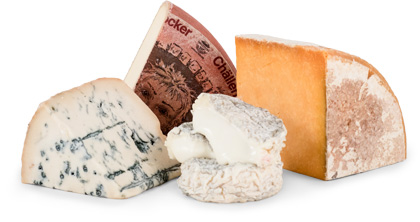First appearing in the markets in the middle of the 20th century, Bleu d'Auvergne is relatively new in the world of cheese. The story goes that an Auvergnat farmer sprinkled mold from rye bread on his milk curd and then pierced the curd with a needle. This allowed the air through and the curd developed blue veins. Although this cheese could be mistaken for Roquefort in looks, it has its own distinct flavor. Compared to Roquefort, it's super-intense and crumbly. Bleu d'Auvergne also has a creamier texture and a more subtle, rustic flavor. It’s made using century-old techniques and an uncompromising attention to quality. The result is a blue that's ideal for both snacking and cooking.
The Auvergne lies in the heart of the Massif Central, a mountain range with a chain of long extinct volcanoes, or "Puy." The Allier is rich farm country with gentle hills and huge forests. The landscape of the Puy-de-Dome and Cantal highlands changes into sweeping glacier valleys, lakes, waterfalls, and a wide plateau. There you will find unspoiled medieval towns and mountain villages. Charming farmhouses rest on the plateaus in the wilds of the Labradors. As you might expect, the people here are warm and friendly. From spring until late autumn, there are country fêtes which are held to celebrate the harvest and the movement of the herds to their mountain pastures. The terrain near Auvergne is craggy and desolate, and actually better suited to raising sheep than cows. Even so, the region manages to produce enough cow's milk to eke out its small annual production of Bleu d'Auvergne. The cheese boasts an abundance of blue veins and a smooth yet intense flavor that blue lovers covet!
This cheese, granted an AOC certification in 1975, tastes of clover, wildflowers, and wild onions. These are the main plants the cows feast on, and what a cow eats really does flavor the milk they produce, as well as the cheese made from that milk. Why are some cheeses designated as AOC? The Appellation d'Origine Controlee, or AOC, applies to wines, eaux-de-vie, dairy, and farmhouse products. It guarantees that a product of quality has been produced within a specified region following established methods of production. The AOC is regulated by laws, the first of which was the Law for the Protection of the Place of Origin of May 6, 1919.
As with the other great blues, you can contrast the heady flavor of Bleu d'Auvergne with the sweetness of fresh fruit, and/or a dessert wine. It's great crumbled on a tossed salad or added directly to your freshly-made vinaigrette; it will mellow the dressing's acidity. Try a small piece on a slice of apple for a beautiful, healthy snack! For a special treat, serve it with Sauterne and toasted nuts or with a full-bodied red wine.

Experience International Variety
You might receive a Gaperon, originating in France during the 14th Century, an
authentic Lancashire by Ruth Kirkham, and an Italian Taleggio matured in the
caves of Valsassina…all in one shipment!

